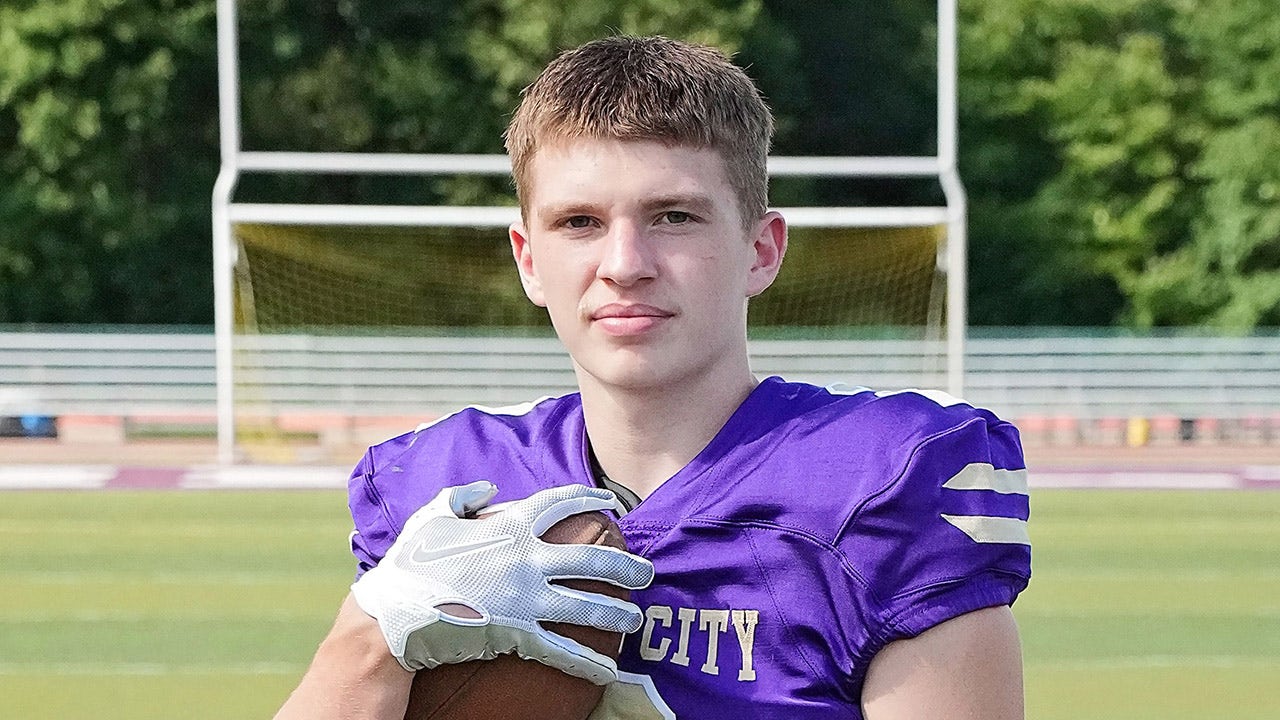Pennsylvania
Pennsylvania high school quarterback undergoes ‘first positive step’ in long recovery after collapse: family

The family of a Pennsylvania high school football player who collapsed and was rushed to the hospital last week provided an update on their son’s health on Monday.
Mason Martin collapsed in the third quarter of Karns City High School’s game against Redbank Valley High School. The incident occurred in the third quarter when Marin stumbled and fell to the ground, according to the Butler Eagle. Martin’s family told KDKA-TV in Pittsburgh that their son suffered a “significant brain bleed as well as a collapsed lung.”
The family released its latest update on Facebook, which was shared on the high school football team’s X account.
CLICK HERE FOR MORE SPORTS COVERAGE ON FOXNEWS.COM
Karns City High School quarterback Mason Martin runs on field. (Holly Mead Photography)
“Within the last 24 hours Mason has demonstrated some purposeful movement in his arms,” the family wrote. “His eyes have slightly reacted to light. He is also retracting his leges when his toes are pinched. His lung has completely recovered and his chest tube has been removed.
“We were waiting to give a social media update at the end of the week knowing he will have more test and changes throughout the week but we wanted to clear up any rumors now. This is the first positive step in an extremely long journey. The prayer vigils held at the hospital and at Karns City have overwhelmed us with his joy and motivation.
“We ask for your continued prayers and support. Thanks again.”

Karns City High School quarterback Mason Martin jumps through sign before game. (Holly Mead Photography)
COACH JOE KENNEDY ON HIS RETURN TO FOOTBALL AND FAITH ON THE FIELD: ‘AMERICA IS ALIVE AND WELL’
Denny Martin, Mason’s father, further explained the situation to WTAE-TV.
“Then they came in afterward and sat us down and spoke to us about what they saw. They said he didn’t respond well,” he told the station.
“There wasn’t much hope. I put out in a Facebook post that we need a miracle. We needed one and people went to work. And within the last 24 hours, he showed improvement that he hasn’t shown before any of these vigils took place.”

Karns City High School quarterback Mason Martin poses for team picture. (Holly Mead Photography)
CLICK HERE TO GET THE FOX NEWS APP
Prayer vigils were held for the 17-year-old player over the weekend. Counselors are reportedly set to be at the school when students arrive Tuesday.

Pennsylvania
Group weighs potential and peril of performance funding for Pa. universities • Pennsylvania Capital-Star

A group of lawmakers, university administrators and the head of the Department of Education heard Tuesday about the possibilities — and perils — of tying public funding of state-related universities at least in part to their performance and students’ academic outcomes.
The Performance-Based Funding Council was created by the General Assembly last summer and tasked with making recommendations on a performance-based funding formula by the end of April. Members include four lawmakers, Interim Acting Secretary of Education Angela Fitterer and three non-voting members from the state-related schools that would be affected: Penn State, Temple University and the University of Pittsburgh. Lincoln University, an HBCU and a fourth state-related university, would not be affected.
Currently, the three state-related schools collectively receive more than $550 million in state funding annually. The move to a performance-based funding formula has been supported by lawmakers from both parties, as well as Gov. Josh Shapiro.
“These legislative hearings offer a unique opportunity to fundamentally reassess how we align public resources and educational outcomes,” said Rep. Jesse Topper (R-Bedford), the council chairperson. “I believe we need to show the public how those resources are used and why — why we invest in higher education.”
More than 30 states already use a performance-based funding model. According to testimony heard by the council, the most common academic targets in states with performance-based funding models include graduation rates, student retention and degree or credential completion. But a potential formula could also take into account factors like research output, administrative efficiency, and employment rates of graduated students.
While policies vary greatly around the country, about 10% of money sent to four-year schools in states with performance-based funding formulas is based on the targeted metrics, according to testimony by Andrew Smalley, a policy specialist who focuses on higher education at the National Conference of State Legislatures.
But experts warned that coming up with a comprehensive formula can be “daunting.”
“Everyone knows that colleges and universities subject to these formulas find themselves in a bit of a Catch-22,” said Charles Ansell, vice president of research, policy and advocacy at Complete College America, a nonprofit focused on best practices in higher education. “They need funds for their performance and improved graduation rates, but they cannot access funds without demonstrating improvement first.”
One potential solution, another expert testified, could be awarding funds based on improvements at an individual school over time instead of an arbitrary benchmark, like graduation rate, that applies to all schools.
Experts also warned that some performance-based funding models can exacerbate disparities in educational outcomes between high- and low-income students, and between white and minority students.
“Performance funding is typically tied to advantages for the advantaged students and disadvantages for the disadvantaged,” said Justin Ortagus, an associate professor of higher education administration and policy at the University of Florida. Though he noted that a funding formula can take these pitfalls into account by incentivizing enrollment and degree or certification attainment for students in impacted groups.
Speakers also highlighted the benefits of performance-based funding models. Ortagus noted that they can promote institutional accountability.
It could also provide predictability when it comes to school budgets.
As it stands, Pennsylvania’s method for funding these universities requires a two-thirds vote of the legislature, which has led to months-long delays in the past. Creating a predictable funding formula that would be distributed through the Department of Education would mean future appropriations would only require a simple majority.
Moreover, lawmakers could use performance metrics to encourage specific educational outcomes. Part of the funding formula, for example, could rely on students enrolling or graduating in programs of study that would lead to them entering high-demand fields in the job market.
The state could also target specific outcomes based on goals like increasing low-income, veteran or minority student graduation rates, encouraging adult education and incentivizing students to enter high-demand jobs by focusing on particular majors. And the formula can be adapted when new needs or issues arise.
“It’s very common for states to revise these frequently,” Smalley said.
The council expects to hold three more hearings, some at the campuses of affected state-related universities. Its recommendations are due to the legislature and governor April 30.
Pennsylvania
High levels of respiratory illness reported across Pennsylvania, New Jersey and Delaware

NEWARK, Del. (WPVI) — If you feel like everyone around you is coughing and sneezing, it’s not your imagination.
The CDC says the level of respiratory illness, including flu, COVID, and RSV, is classified as “high” in Pennsylvania and New Jersey, while Delaware is classified as “very high.”
Doctors say they’re seeing it all.
“Everyone is sick. We have RSV going on. We have flu. We have COVID going on. We have GI distress. Essentially, you’re getting sick in some fashion,” said Dr. Theresa Metanchuk, the Regional Clinical Director for ChristianaCare.
Dr. Claiborne Childs, the vice president of medical affairs at Riddle Hospital, is seeing the same thing.
“It’s sort of a confluence of all the different viruses all together. We’re seeing an uptick all around the hospital,” Childs said.
We’re at the center of the respiratory illness season.
“We still have some time to go. We have the rest of the month of January, February and early March,” said Dr. Childs.
That means there is still time to protect yourself with vaccines.
Dr. Metanchuk said the latest statistics show this year’s flu shot is 40% beneficial, which she said is “better than nothing.”
“They’re meant to keep you out of the hospital. They are meant to limit how severe the illness makes you,” she said.
As people heal from those illnesses, their bodies are at greater risk.
“Whenever you get sick, our immune system has to get a chance to recuperate, bounce back, so we’re more likely to get sick with something else,” said Dr. Metanchuk.
Staying hydrated, working out, and eating healthy – common New Year’s resolutions – are good ideas for preventing these illnesses too.
Copyright © 2025 WPVI-TV. All Rights Reserved.
Pennsylvania
Wegmans expands to new market with upcoming store

Wegmans on Monday announced plans to build a location in Cranberry Township, Pennsylvania, part of the Pittsburgh metropolitan area.
The 115,000-square-foot store will sit on 13 acres on Cool Springs Drive, adjacent to the UPMC Lemieux Sport Complex, an outpatient sports medicine facility and the primary training home for the NHL’s Pittsburgh Penguins.
“We’ve received thousands of requests for a Wegmans in the Pittsburgh region since opening our first Pennsylvania store over 30 years ago,” Dan Aken, vice president of real estate and store planning, said in a statement. “We’re excited to have finally found the right location to bring Wegmans to the Pittsburgh area.”
The new location will be part of the Cranberry Springs mixed-use development, which includes luxury single-family homes and apartments, Class A office buildings and other retail operations, including restaurants.
How many jobs expected at new Wegmans?
The company expects to hire 400 to 500 employees, the majority of them local.
Timeline for new Wegmans
A timeline for construction and opening has not yet been determined.
How many stores does Wegmans have?
Headquartered in Rochester, Wegmans has 111 stores along the East Coast.
Reporter Marcia Greenwood covers general assignments and has an interest in retail news. Send story tips to mgreenwo@rocheste.gannett.com. Follow her on X @MarciaGreenwood.
-

 Health1 week ago
Health1 week agoOzempic ‘microdosing’ is the new weight-loss trend: Should you try it?
-
/cdn.vox-cdn.com/uploads/chorus_asset/file/25822586/STK169_ZUCKERBERG_MAGA_STKS491_CVIRGINIA_A.jpg)
/cdn.vox-cdn.com/uploads/chorus_asset/file/25822586/STK169_ZUCKERBERG_MAGA_STKS491_CVIRGINIA_A.jpg) Technology6 days ago
Technology6 days agoMeta is highlighting a splintering global approach to online speech
-

 Science4 days ago
Science4 days agoMetro will offer free rides in L.A. through Sunday due to fires
-
/cdn.vox-cdn.com/uploads/chorus_asset/file/25821992/videoframe_720397.png)
/cdn.vox-cdn.com/uploads/chorus_asset/file/25821992/videoframe_720397.png) Technology1 week ago
Technology1 week agoLas Vegas police release ChatGPT logs from the suspect in the Cybertruck explosion
-

 Movie Reviews1 week ago
Movie Reviews1 week ago‘How to Make Millions Before Grandma Dies’ Review: Thai Oscar Entry Is a Disarmingly Sentimental Tear-Jerker
-

 Health1 week ago
Health1 week agoMichael J. Fox honored with Presidential Medal of Freedom for Parkinson’s research efforts
-

 Movie Reviews1 week ago
Movie Reviews1 week agoMovie Review: Millennials try to buy-in or opt-out of the “American Meltdown”
-

 News1 week ago
News1 week agoPhotos: Pacific Palisades Wildfire Engulfs Homes in an L.A. Neighborhood















